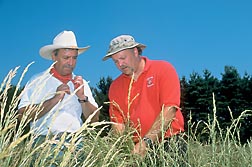Peter and the Festulolium Stalk
|
|
When Peter Pitts moved to Wisconsin in 1980 and bought a sack of grass seed, he never dreamed he’d be earning royalties from this seed’s offspring becoming both a widely popular conventional grass seed and the first ryegrass in North America to be certified organic.
Having seen the virtues of ryegrass when he lived in Oregon and worked for a seed company, he wanted to plant a ryegrass pasture on the 320-acre farm he bought to raise beef cattle.
The merchant suggested festulolium (pronounced “fes-tu-lo-lium”), a ryegrass (Lolium) bred in Europe to contain some desirable meadow fescue (Festuca) genes.
Pitts planted it, and it did extraordinarily well on his mostly organic farm. After 6 years of success, Pitts visited Michael Casler, who was then a professor at the University of Wisconsin but is now a geneticist at the Agricultural Research Service’s U.S. Dairy Forage Research Center in Madison, Wisconsin.
Pitts asked Casler why the university didn’t recommend festulolium or ryegrass—both nutritious perennials—for pastures. Casler replied, “Because they never last more than a year.”
Pitts replied, “My festulolium has lasted 6 years, despite being overgrazed and underfertilized. It has survived all those Wisconsin winters and the droughts of 1988 and 1989.”
Casler couldn’t believe this, so he accepted Pitts’s invitation to visit his farm in Spring Green, Wisconsin, about 40 miles northwest of Madison.
Get Tough or Die
Casler and Pitts dug up some sample plants, and Casler bred them with some of the long-lived festulolium plants in old university nursery plots throughout Wisconsin. These plants represented a very small number of plants that had survived “get tough or die” conditions similar to those on Pitts’s pasture.
But Casler needed supporting data before he could proceed with a formal release of the new variety. So Pitts received a U.S. Department of Agriculture small business grant and teamed up with Pure-Seed Testing, Inc., of Hubbard, Oregon, to conduct experiments to prove that the new plant was superior forage. Pure-Seed Testing’s breeder, Crystal Fricker, screened the plants in Oregon for stem rust resistance, yield, and other desired characteristics. Together they documented improved freezing tolerance and persistence in the northern United States. In 1996, breeder seed of the new variety, named Spring Green, was produced.
Rose Agri-Seed, Inc., a sister company of Pure-Seed Testing, Inc., obtained exclusive marketing rights for Spring Green. The seed proved so popular that it is used throughout the world and is now sold by Land O’ Lakes, Inc—.in St. Paul, Minnesota—a distributor of Rose Agri-Seed. More than a million pounds of the conventionally grown seed were sold in its first 5 years on the market. It is becoming a staple ingredient in forage seed mixes.
Spring Green Goes Green
Bill Rose of Rose Agri-Seed later had seed grown in Alberta, Canada, on land certified for organic farming. In its first few years on the market, 200,000 pounds of the organically grown seed were sold. Pitts, the University of Wisconsin, and Pure-Seed Testing, Inc., share ownership of Spring Green.
Casler calls Pitts the only farmer-grass breeder he knows. “This release would not have happened without the partnership between us and Pitts,” says Casler. “This type of participatory breeding is rare in developed countries. It represents a new paradigm in the development of forage grass varieties for the United States: the direct involvement of a farmer throughout the development and marketing phases.”
Casler and Pure-Seed Testing, Inc. continue to work with Spring Green in breeding new forage plants and developing better management techniques for more economically and environmentally sustainable pastures.—By Don Comis, Agricultural Research Service Information Staff.
This research is part of Pasture, Forage, and Rangeland Systems, an ARS national program (#215) described at www.nps.ars.usda.gov.
Michael D. Casler is in the USDA-ARS Dairy Forage and Aquaculture Research Unit, U.S. Dairy Forage Research Center, 1925 Linden Drive West, Madison, WI 53706; (608) 890-0076.
"Peter and the Festulolium Stalk" was published in the November/December 2011 issue of Agricultural Research magazine.







